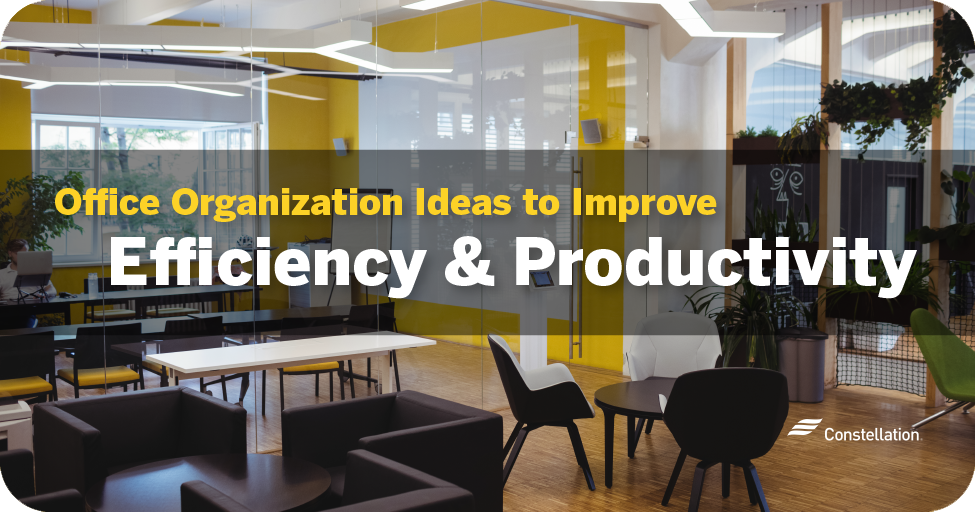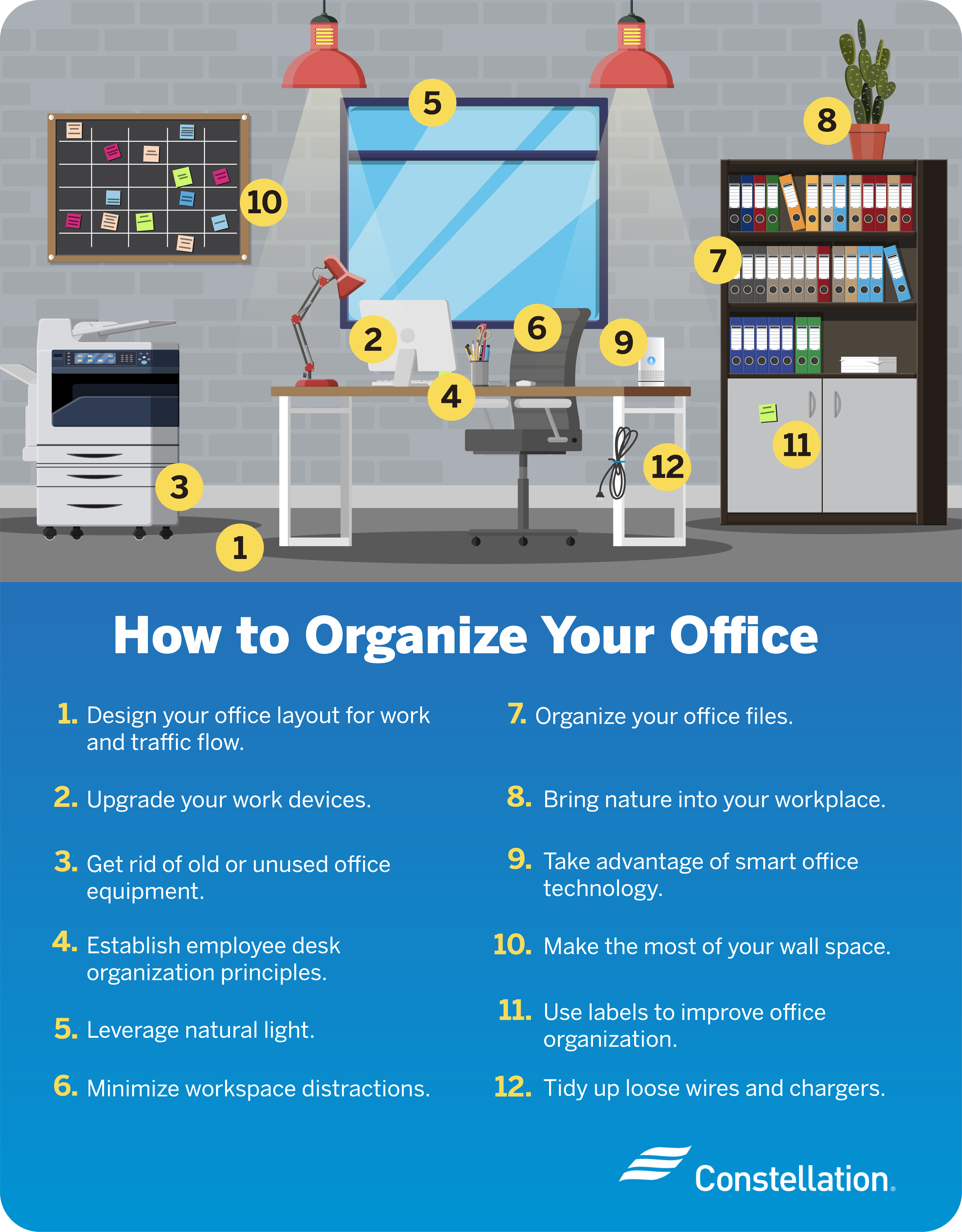
- Category:
Small Business Energy Savings -
Last updated:
November 1, 2024
12 Office Organization Ideas to Improve Efficiency & Productivity
These office organization ideas will tame clutter and create a more efficient environment for your business. A well-thought-out office layout brings tangible benefits to your work atmosphere, with efficiencies you may see on your bottom line. When your workspaces are organized, productivity and morale improve.
When you design a workspace to be flexible and resilient, you can better accommodate rush work and seasonal spikes in activity. Office layout ideas that improve space utilization can save you from acquiring more square footage. Productive workspaces also reduce stress and anxiety, improving work culture.
12 office organization & layout tips for a more productive workplace
You don’t have to be a professional organizer to know how to improve the arrangement of your office. These work office organization ideas and tips are easy to put in place and to maintain over time. Once you get organized, you can stay organized.
1. Design your office layout based on your work and traffic flow
Many people lay out an office without thinking about work and traffic flows. You may have placed things in a small office because of tradition or random choices. To optimize space utilization and to improve efficiency, think about how work and people move through your space and develop office layout ideas accordingly.
When thinking about people, consider more than just your staff. Contractors, service providers, clients and visitors will move through your space. Organizing an efficient office space layout around these flows increases productivity and makes the best use of your area.
Consider more than work spaces when rethinking a more productive office. Think about the break room as well. The break room is a place where you can express company culture and create a relaxing and inviting space for employees.
2. Upgrade your work devices to save space and energy
Newer equipment and devices contribute to office space efficiency by using less energy and taking up less space. Laptops are as powerful as a desktop and are typically more energy-efficient.
Multi-functional devices, like all-in-one printers and scanners, reduce the need to make space for multiple machines. As with computers, the newer devices are typically more energy-efficient.
3. Get rid of old or unused office equipment
Do you need all those filing cabinets after you’ve gone paperless? You can recycle old office equipment and outdated furniture to open up space. Charities and start-ups are often eager for your cast-offs.
4. Establish employee desk organization principles
Involving your employees is a great idea when making your workspace more productive. Encourage staff members to make their own spaces more productive and ask them to design workspace improvements that make sense with their workflows. For example, arranging their desk based on frequency of use and positioning their monitor at least 20 inches in front of them.
- Provide employees with tools and equipment they can use to design workspace upgrades.
- Encourage employees to collaborate and share their own office organization tips with others.
- Use office etiquette signs to share good ideas and to remind people about office organization routines.
- Make decluttering a part of the culture and schedule regular cleanouts to maintain a focused work environment.
- Implement a “one-in/one-out” policy that requires removing an item when a new item is brought in.
- Clearly label items with a standardized naming convention.
5. Leverage natural light when designing your workplace
A well-lit space feels more orderly than those with dark corners and shadows. Work office organization ideas that use natural sunlight are more effective than those that rely exclusively on artificial lighting. Placing desks near windows is a great way to boost morale as you brighten workspaces. Making good use of daylighting in an efficient office space layout is also a way to keep office energy consumption down.
6. Minimize workspace distractions
A productive workspace is free of unnecessary distractions. Remove sound clutter as you remove visual clutter. Use decor that absorbs sound and white noise machines to encourage a calming level of quiet—tactics that are particularly helpful if you have an open office design. Place desks so that workers have some privacy. Setting quiet time hours may improve work concentration.

7. Organize your office files
Stacks of paper and towers of files that cover desks and tables create a chaotic-looking office space. If you want to keep your office organized, someone has to sort and file these materials away. When you go digital, you eliminate both the clutter and the effort needed to deal with it, thus freeing employees for more productive tasks.
You can improve office organization ideas through a digital transformation process when you design workspace changes. Beyond office space efficiency, your business benefits from being able to better collect, control, and use information. You can enjoy improved communication and cost savings.
Tips for a more productive office include organizing your physical and digital space. You’ll know where to access things and how to find what you need fast. Design a filing system and train employees to maintain it to streamline processes and keep disorder at bay.
Name files to include a date, client name, project-by-workstream label, and version. Move old, infrequently used files onto an external drive, and don’t keep things just for the sake of keeping them. Deleting old files is as important as categorizing new ones.
8. Bring nature into your workplace
Bringing plants into your workspace improves your office layout ideas. In addition to improving decor, plants improve your workplace by reducing toxins, alleviating stress and fatigue, improving mood, and boosting concentration and productivity by 15%.
9. Take advantage of smart office technology
Using smart assistants at work, especially in combination with smart office technologies, can help work flow better through your operation, eliminate excess steps, and provide metrics to help you measure productivity and find the bottlenecks to eliminate. Using a voice assistant can keep you from cluttering your office with reminder notes—and, better yet, automate repetitive tasks that might otherwise clutter your mind.
When you automate your office, you can reduce clutter in spaces and processes. Eliminating repetitive tasks can improve organization, remove clutter, increase efficiency, and even reduce your small business’s energy consumption.
10. Make the most of your wall space
Don’t just look to your floor space for storage. Go vertical and up the walls with shelving to store things. Install whiteboards and corkboards for organizational processes. You can store more things per square foot when you go up.
11. Use labels to improve office organization
Labels help you find materials and equipment when you need them—and know where to put them when you have finished using them. Don’t just label things; label their locations, as well. Labels also help people understand functions and processes at a glance. It all adds up to better office organization.
12. Tidy up loose wires and chargers
Even in our wireless world, wired devices and networks continue to multiply. They clump and tangle endlessly, creating visual chaos and a potential fire hazard. And you might find yourself dealing with knots when you want to unplug a single device. Using cord management devices and cord labels can tame this chaos, keeping wiring both safe and simple.
The benefits of work office organization and an efficient office space layout
A productive workspace incorporates office organization ideas like these and an efficient layout that improves workflows. But there is more to it than that. A well-ordered space improves employee mood and morale and provides an environment that boosts concentration.




